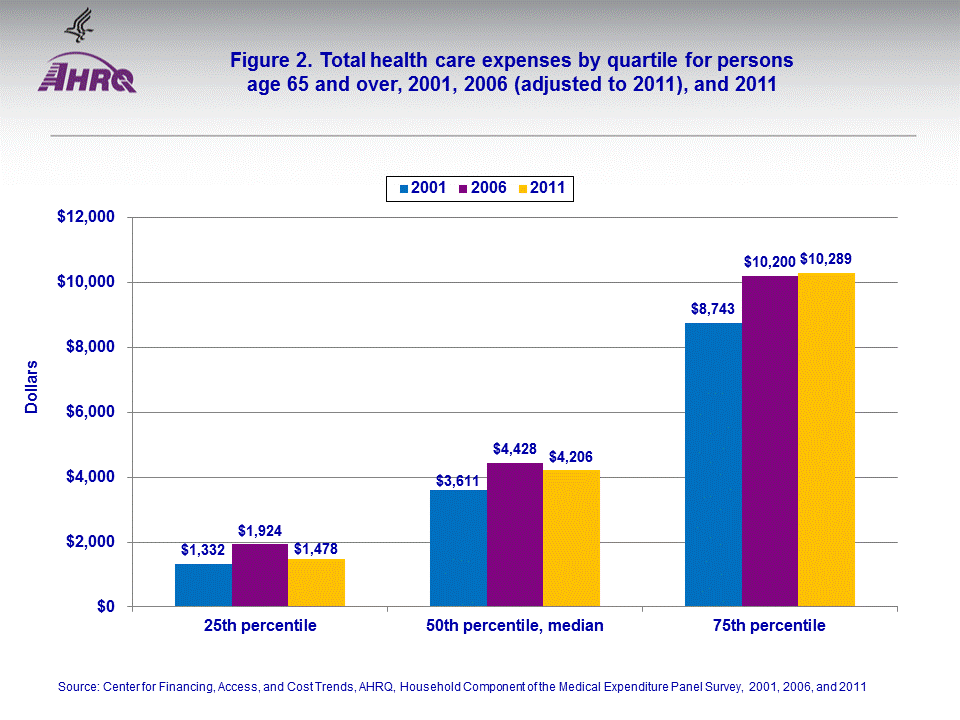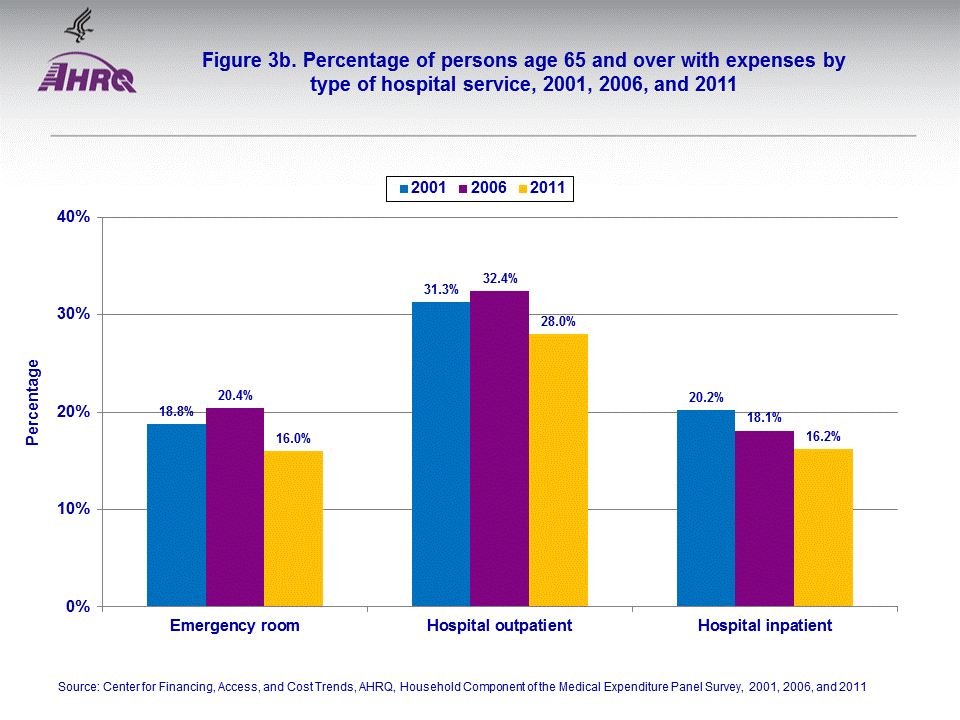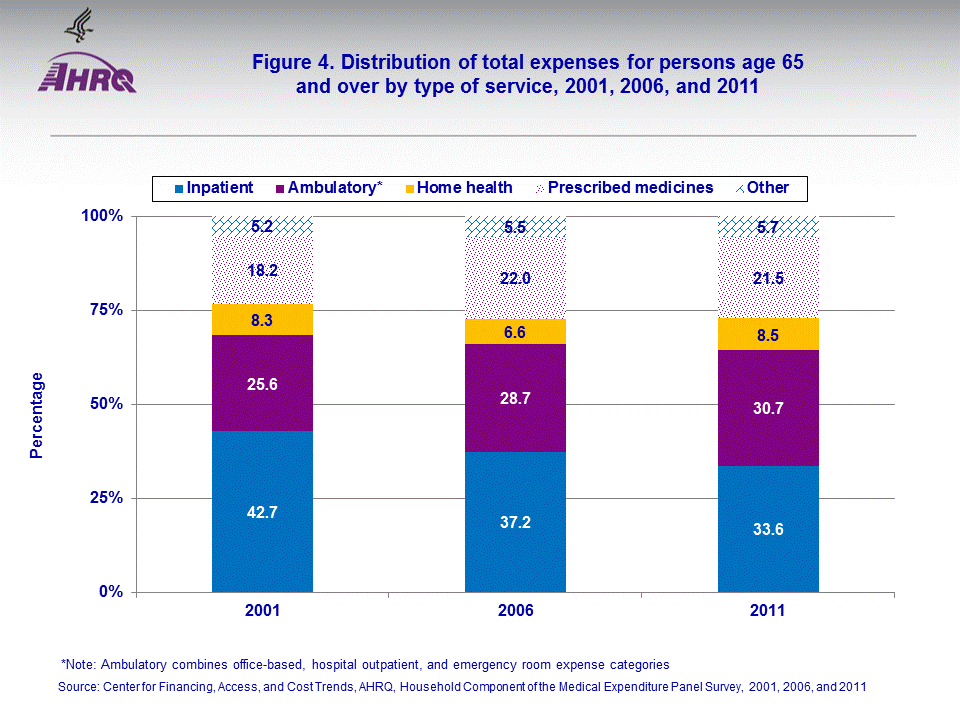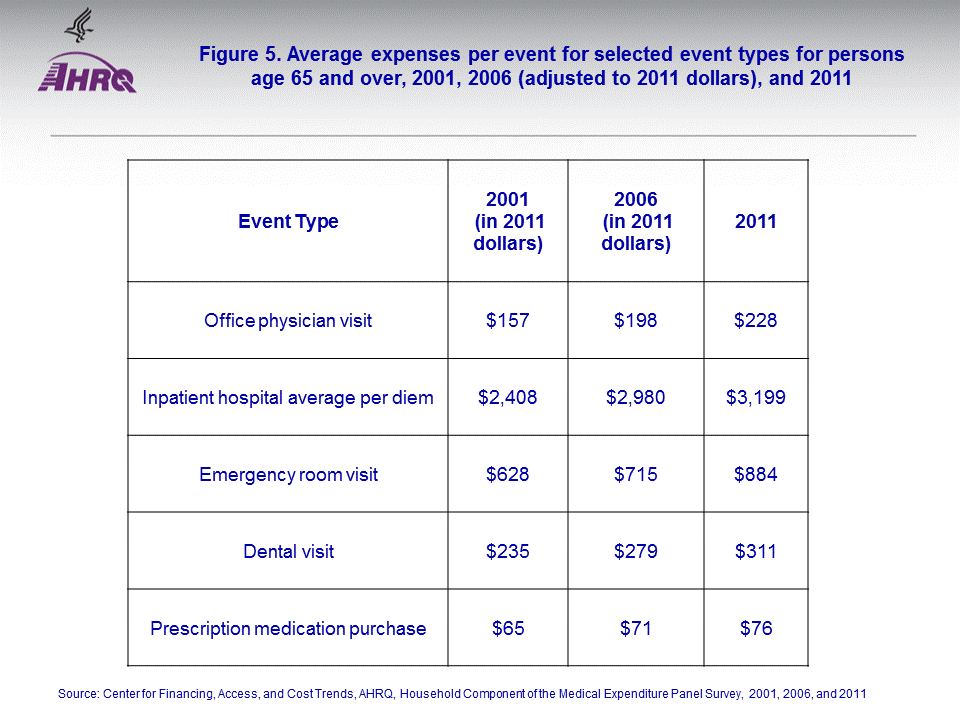
|
|
Font Size:
|
||||
|
|
|
|
||||
STATISTICAL BRIEF #429:
Trends in Health Care Expenditures for the Elderly, Age 65 and Older: 2001, 2006, and 2011
Highlights
- A similar proportion (about 96 percent) of the elderly had some expenses for health care in 2001, 2006, and 2011.
- In 2011, the average total annual expense per person with expenses was higher than 2001 for the elderly.
- The proportion of the elderly with expenses for dental visits in 2011 was higher than 2001. Conversely, the proportions with emergency room, outpatient, and inpatient hospital expenses were lower in 2011 than 2001.
- Among persons age 65 and over, the portion of total expenses accounted for by inpatient care was lower in 2011 than 2001 while the portions for ambulatory care and prescribed medicines were higher.
- The average expense per office visit and prescription medicine purchase for the elderly was higher in 2011 than in 2006 or 2001. The average expense for an inpatient hospital stay per day, an emergency room visit, and a dental visit was significantly higher in 2011 than 2001.
Introduction
This Statistical Brief compares summary statistics on health care expenditures and expenditure distributions by type of service and sources of payment for the elderly (age 65 and over) in 2001, 2006, and 2011. The estimates are derived from data collected in the Medical Expenditure Panel Survey Household (MEPS-HC) and Medical Provider Components (MEPS-MPC) on the U.S. civilian noninstitutionalized population. Health care expenses in MEPS represent payments to physicians, hospitals, and other health care providers for services reported by respondents to the MEPS-HC. Estimates for 2001 and 2006 were adjusted to 2011 dollars based on the Gross Domestic Product (GDP) Price Index to remove the impact of medical price inflation on comparisons (http://www.meps.ahrq.gov/mepsweb/about_meps/Price_Index.shtml). All differences between estimates noted in the text are statistically significant at the 0.05 level or better.Findings
Summary expenditure statisticsThe $414.3 billion in total health care expenses for the elderly in 2011 was over $100 billion higher than inflation-adjusted expenses for 2001 (figure 1). A similar proportion of the elderly had some expenses for health care in the three years, about 96 percent. The average annual expense per person with expenses was about $1,000 higher in 2011 ($9,863) than 2001 ($8,815 in 2011 dollars). However, the difference between average expenses in 2006 and 2011 was not statistically significant.
In 2011, the median annual health care expenditure for persons age 65 and over was $4,206 (figure 2), with about one-quarter of the elderly having expenses under $1,478 (25th percentile) and one-quarter having expenses over $10,289 (75th percentile). These quartile levels were higher than in 2001 (after adjusting for inflation from 2001 to 2011 dollars).
Expenditures by type of service
While the proportions of the elderly with expenses for office-based visits, for prescribed medicines and for home health care were fairly similar across the three years, the proportion with expenses for dental visits was higher in 2011 (43.6 percent) than 2001 (39.3 percent) (figure 3a). Conversely, the proportions with emergency room, outpatient, and inpatient hospital expenses were lower in 2011 than 2001 (figure 3b).
Among persons age 65 and over, the portion of total expenses accounted for by inpatient care was lower in 2011 (33.6 percent) than 2001 (42.7 percent) while the portions for ambulatory care and prescribed medicines increased (from 25.6 to 30.7 and 18.2 to 21.5 percent, respectively) (figure 4), but did not differ significantly from 2006. In contrast, the proportions for home health care and for other types of services did not vary significantly across the three years.
Expenditures by source of payment
Medicare paid for a larger proportion of total health care expenses for the elderly in 2011 (62.4 percent) than 2001 (54.7 percent). A smaller proportion was paid out of pocket in 2011 (12.3 percent) than 2006 (15.2 percent) or 2001 (18.1 percent) (figure 6). Some of these shifts are likely attributable to implementation of Medicare Part D in 2006.
Data Source
The estimates in this Statistical Brief are based upon data from the 2011, 2006, and 2001 Full Year Consolidated (HC-147, HC-105, and HC-60, respectively) and Event Level Data Files (HC-144, HC-102, and HC-59 A, B, D, E, and G).Definitions
Expenditures (expenses)Expenditures include the total direct payments from all sources to hospitals, physicians, other health care providers (including dental care), and pharmacies for services reported by respondents in the MEPS-HC. Expenditures for hospital-based services include those for both facility and separately billed physician services. Estimates for 2001 and 2006 were adjusted to 2011 dollars based on the GDP Price Index (http://www.meps.ahrq.gov/mepsweb/about_meps/Price_Index.shtml). Health insurance premiums are not included as expenses.
Type of service
- Office-based: Includes expenses for visits to both physician and non-physician medical providers seen in office settings.
- Hospital inpatient: Includes room and board and all hospital diagnostic and laboratory expenses associated with the basic facility charge, payments for separately billed physician inpatient services, and some emergency room expenses incurred immediately prior to inpatient stays.
- Hospital outpatient: Includes expenses for visits to both physicians and other medical providers seen in hospital outpatient departments, including payments for services covered under the basic facility charge and those for separately billed physician services.
- Emergency room: Includes payments for services covered under the basic facility charge and those for separately billed physician services, but excludes expenses for emergency room services that are included in a hospital inpatient admission.
- Prescribed medicines: Includes expenses for all prescribed medications that were initially purchased or refilled during the year, as well as expenses for diabetic supplies.
- Dental: Includes payments for services to any type of dental care provider, including general dentists, dental hygienists, dental technicians, dental surgeons, orthodontists, endodontists, and periodontists.
- Ambulatory: Combines office-based, hospital outpatient, and emergency room expense categories described above.
- Home health: Includes expenses for home care provided by agencies and independent providers.
- Other: Includes expenses for care in all categories not specified as a separate category including those for miscellaneous medical equipment and supplies.
- Out of pocket: This category includes expenses paid by the user or other family member.
- Private insurance: This category includes payments made by insurance plans covering hospital and medical care (excluding payments from Medicare, Medicaid, and other public sources), Medigap plans, or TRICARE (Armed Forces-related coverage). Payments from plans that provide coverage for a single service only, such as dental or vision coverage are not included.
- Medicare: Medicare is a federally financed health insurance plan for the elderly, persons receiving Social Security disability payments, and most persons with end-stage renal disease. Medicare Part A, which provides hospital insurance, is automatically given to those who are eligible for Social Security. Medicare Part B provides supplementary medical insurance that pays for medical expenses and can be purchased for a monthly premium.
- Other sources: This category includes payments from Medicaid/SCHIP, other miscellaneous Federal sources (Indian Health Service, military treatment facilities, and other care provided by the Federal government); various state and local sources (community and neighborhood clinics, state and local health departments, and state programs other than Medicaid/SCHIP); various unclassified sources (e.g., automobile, homeowners', or other liability insurance, and other miscellaneous or unknown sources); Medicaid/SCHIP payments reported for persons who were not reported as enrolled in the Medicaid or SCHIP programs at any time during the year; and private insurance payments reported for persons without any reported private health insurance coverage during the year.
About MEPS-HC
MEPS-HC is a nationally representative longitudinal survey that collects detailed information on health care utilization and expenditures, health insurance, and health status, as well as a wide variety of social, demographic, and economic characteristics for the U.S. civilian noninstitutionalized population. It is cosponsored by the Agency for Healthcare Research and Quality and the National Center for Health Statistics.For more information about MEPS, call the MEPS information coordinator at AHRQ (301) 427-1406 or visit the MEPS Web site at http://www.meps.ahrq.gov/.
References
For a detailed description of the MEPS survey design, sample design, and methods used to minimize sources of nonsampling error, see the following publications:Cohen, J., Cohen S., and Banthin, J. "The Medical Expenditure Panel Survey: A National Information Resource to Support Healthcare Cost Research and Inform Policy and Practice." Medical Care 2009, 47(7), Supplement, pp S44–S50.
Cohen, J. Design and Methods of the Medical Expenditure Panel Survey Household Component. MEPS Methodology Report No. 1. AHCPR Pub. No. 97-0026. Rockville, MD: Agency for Health Care Policy and Research, 1997. http://www.meps.ahrq.gov/mepsweb/data_files/publications/mr1/mr1.shtml
Ezzati-Rice, T.M., Rohde, F., Greenblatt, J. Sample Design of the Medical Expenditure Panel Survey Household Component, 1998–2007. Methodology Report No. 22. March 2008. Agency for Healthcare Research and Quality, Rockville, MD. http://www.meps.ahrq.gov/mepsweb/data_files/publications/mr22/mr22.shtml
Suggested Citation
Mirel, L.B., and Carper, K. Trends in Health Care Expenditures for the Elderly, Age 65 and Over: 2001, 2006, and 2011. Statistical Brief #429. January 2014. Agency for Healthcare Research and Quality, Rockville, MD. http://www.meps.ahrq.gov/mepsweb/data_files/publications/st429/stat429.shtmlAHRQ welcomes questions and comments from readers of this publication who are interested in obtaining more information about access, cost, use, financing, and quality of health care in the United States. We also invite you to tell us how you are using this Statistical Brief and other MEPS data and tools and to share suggestions on how MEPS products might be enhanced to further meet your needs. Please email us at MEPSProjectDirector@ahrq.hhs.gov or send a letter to the address below:
Steven B. Cohen, PhD, Director
Center for Financing, Access, and Cost Trends
Agency for Healthcare Research and Quality
540 Gaither Road
Rockville, MD 20850
 |
||||||||||||||||||||||||||||||
|
||||||||||||||||||||||||||||||
|
|
||||||||||||||||||||||||||||||
 |
||||||||||||||||||||||||||||||
|
||||||||||||||||||||||||||||||
|
|
||||||||||||||||||||||||||||||
 |
||||||||||||||||||||||||||||||
|
||||||||||||||||||||||||||||||
|
|
||||||||||||||||||||||||||||||
 |
||||||||||||||||||||||||||||||
|
||||||||||||||||||||||||||||||
|
|
||||||||||||||||||||||||||||||
 |
||||||||||||||||||||||||||||||
|
||||||||||||||||||||||||||||||
|
|
||||||||||||||||||||||||||||||
 |
||||||||||||||||||||||||||||||
|
||||||||||||||||||||||||||||||
|
|
||||||||||||||||||||||||||||||
 |
||||||||||||||||||||||||||||||
|
||||||||||||||||||||||||||||||
|
|
||||||||||||||||||||||||||||||


